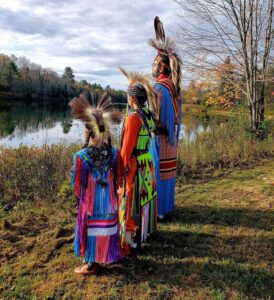A lesson in Indigenous traditional math

By Kelly Anne Smith
NIPISSING FIRST NATION— Math is neat and involved in everyday life says cheery teacher Bryan Bellefeuille.
A member of Nipissing of First Nation, Bellefeuille is an Ojibwe Language teacher working for the Algoma District School Board. His job also involves integrating Indigenous knowledge into the existing Ontario Curriculum he says, “to help other teachers involve and include more Indigenous knowledge into their existing lessons in the classroom.”
Bellefeuille illuminated traditional math during a virtual lesson for the Ontario Science Centre on Sept. 22 for children 6 – 12 years old.
The engaging teacher is a firekeeper, grass dancer, and fisherman. Speaking from Mississauga #8 First Nation, he explains how math is neat.
“It can be flexible and conceptual in applied situations where you are articulating the relationship between the bow and arrow when it’s bending and we have pressures of force at work of trying to obtain a goal of eventually hunting and getting an animal.”
Bellefeuille used woven baskets constructed by Indigenous people to talk about volume and capacity.
“I’m letting people understand that Indigenous people purposefully designed containers to have capacity for particular purposes such as when our ash baskets have holes in them, they are not great for water whereas a birchbark basket would be good for holding more fluid items.”
Bellefeuille showed the intent of design in traditional objects.
“There were purposes behind our things. We constructed them and engineered them with purpose. Because of that, we did math, we just never articulated it as such,” he explained. “Designing and gathering of the ash strips for baskets is a complex process that is not only labour intensive but is knowledge skill intensive as well. That’s really where the science comes in.”
Bellefeuille informed students across the globe that Indigenous people have always used math.
“Indigenous people do have mathematics that we practice and articulate it to each other daily. And we weren’t just simply hunter gatherer’s people walking through the bush looking for the next meal. We planned and designed the communities we live in to be purposeful. To have meaning. We were engineers to be successful in gardening practices and raising our children.”
Bellefeuille demonstrated the importance of the cone shape in the design of a teepee.
“My attempt at this talk is to get that understanding that we absolutely have knowledge of airflow, of heat transfer, of calculus, of geometry. We have all of these fields of mathematics, including discreet mathematics. We practised it in applied settings, we just didn’t write it down using its formula. We did it ourselves.”
Bellefeuille’s Traditional Indigenous Mathematics video has about 10,000 views.

